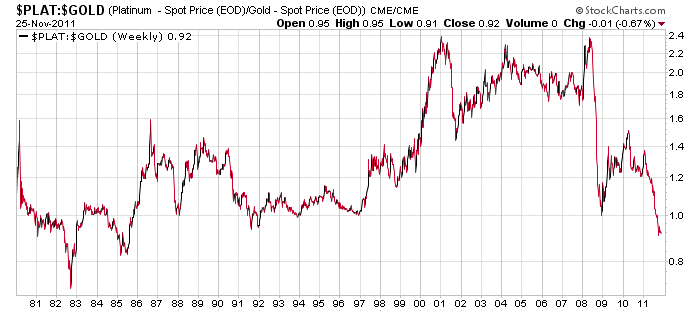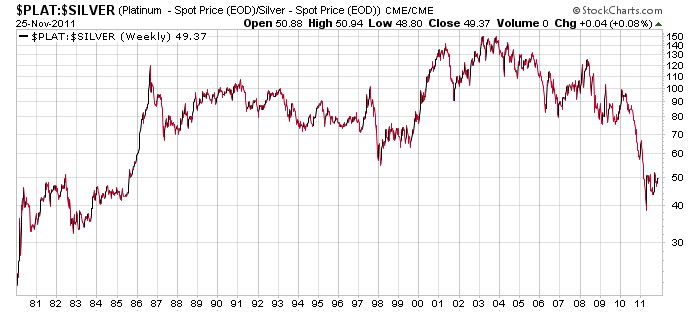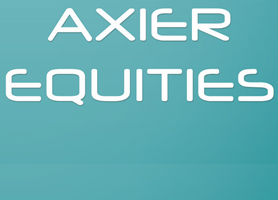Analys
Silver versus platina
 Sedan silverpriset toppade i början av april i år har det fallit tillbaka från toppnoteringen kring 50 USD per troy ounce och har sedan etablerat sig kring dagens nivå om 32 USD per troy ounce. Under samma period har guldpriset fortsatt sin upptrend. Givet detta kan silver anses vara ett köp, i alla fall för den som ser det som ett relativitetsköp. Det kan vara så, men frågan är om inte platina erbjuder ett ännu bättre tillfälle till köp?
Sedan silverpriset toppade i början av april i år har det fallit tillbaka från toppnoteringen kring 50 USD per troy ounce och har sedan etablerat sig kring dagens nivå om 32 USD per troy ounce. Under samma period har guldpriset fortsatt sin upptrend. Givet detta kan silver anses vara ett köp, i alla fall för den som ser det som ett relativitetsköp. Det kan vara så, men frågan är om inte platina erbjuder ett ännu bättre tillfälle till köp?
Först av allt, låt oss titta på platinapriset relativt silver och guld ur ett historiskt perspektiv. Genom att använda platinapriset i förhållande till de övriga ädelmetallerna kan vi se hur de andra metallerna handlas relativt varandra både nu och historiskt. I dag är ration platina/guld lägre än 1,0 vilket indikerar att platinapriset är lägre än guldpriset, något som är tämligen sällsynt. Det normala är att platinapriset handlas över priset på guld
Notera också att platina handlas till låga nivåer jämfört med silverpriset, endast femtio gånger dyrare. Siffran kan förefalla hög, men det är faktiskt ”bara” som är det ordet som gäller. Senaste gången vi såg motsvarande prisrelation, 1:50 mellan silver och platina var 1985. Nivån brukar således vara betydligt högre.
En annan faktor som gör att vi anser att det är intressant att titta på platina är att guld och silver handlas en bra bit över produktionskostnaden, något som inte är fallet med platina. Precis som allt annat har cash-kostnaden för att utvinna ett troy ounce guld stigit, och den närmar sig nu 600 USD per troy ounce. Silver kostar närmare 5 USD per troy ounce, givet att vi talar green field gruvbrytning utan möjligheter att dra fördel av produktionen av basmetaller som zink och bly.
Analysteamet på Standard Bank konstaterar att “från ett kostnadsperspektiv så är platina köpvärt till priser under 1.550 USD per troy ounce” Vi kan bara hålla med dem om detta.Eftersom silvret i dag handlas till ett pris om cirka 32 USD per troy ounce så säljs det till över 600 procent av produktionskostnaderna, samma siffra är 200 procent för guldet. Platina däremot säljs till ett pris på råvarubörserna som ligger i närheten av produktionskostnaderna. Det betyder att silver och guldpriset kan komma att falla betydligt mer än platinapriset innan producenterna, det vill säga gruvorna, gör åtstramningar i fråga om fortsatt produktion för att minska sina förluster. Enligt lagen om tillgång och efterfrågan vet vi att minskad produktion ger ett minskat utbud, något som höjer priset, allt annat lika. Det finns därför anledningen att tro att priset på platina kan vara ett betydligt bet än det både guld och silver.
Platina startar en tillfällig uppgång. Men sen då?
När vi senast gjorde en teknisk analys på Platina var priset 1 604 USD/oz och datumet var den 1 november. Det första av våra uppgångsmål för hösten var redan infriat och det andra, på 1 670 USD/oz var nästan nått i och med en notering i 1 661 USD/oz. Även om det fanns utrymme för en avslutande uppgång för att helt infria målet, var nya nedgångar sedan att vänta eftersom den långsiktiga trenden var fallande.
De senaste fyra veckorna har Platina följt kartan mycket trofast. Vi fick en avslutande uppgång till 1 676 USD/oz den 9 november, men där tog kraften slut. Uppgången var fullbordad och vårt mål på 1 670 USD/oz som vi satte redan i början av oktober, var infriat till fullo.
I den efterföljande nedgången, som pågår än idag, är noteringen i 1526 USD/oz i fredags, den lägsta hittills. Frågan är förstås om denna nedgång på 9 procent från toppen, ska räcka? Ja, tillfälligtvis bör den göra det i alla fall.
De senaste tre månaderna har Platina skapat en fallande trend och sammanbinder vi topparna i denna nedgång, får vi en trendlinje som idag har värdet 1 618 USD/oz (se diagrammet). Denna trendlinje bör nu testas igen.
Datummässigt är det början av nästa vecka, 5-7 december som kommer att ge oss viktiga ledtrådar om den fortsatta utvecklingen i Platina. En topp i detta tidsfönster varnar för fortsatta nedgångar, medan en tydlig lågpunkt talar för att den fallande trendlinjen kan komma att ge vika under vintern.
Eftersom vi fortfarande lever med informationen att en nedgång mot 1100-1200 under vintern inte är utesluten, ser vi alla uppgångar som tillfälliga i en fallande marknad tills vi får signaler om något annat. En första signal om trendändring skulle vara om den fallande trendlinjen på 1618 USD/oz bryts. Och en ny långsiktig uppgång anser vi har påbörjats den dag som Platina stänger över motståndet 1658-1676 USD/oz.
Du kan handla PLATINA med följande minifutures:
Uppgång MINILONG PLAT A med en hävstång kring 4,56
Nedgång: MINISHRT PLAT D med en hävstång kring 4,61
Läs mer om minifutures på RBS hemsida
[box]Denna analys publiceras på Råvarumarknaden.se med tillstånd och i samarbete med Axier Equities.[/box]
Ansvarsfriskrivning
Den tekniska analysen har producerats av Axier Equities. Informationen är rapporterad i god tro och speglar de aktuella åsikterna hos medarbetarna, dessa kan ändras utan varsel. Axier Equities tar inget ansvar för handlingar baserade på informationen.
Om Axier Equities
Axier Equities erbjuder såväl institutionella placerare som privatpersoner den erfarenhet, kompetens och analysredskap som krävs för en trygg och effektiv handel på de finansiella marknaderna. Axier Equities erbjuder ingen handel, vare sig för egen räkning eller för kunder utan arbetar endast med finansiell marknadsföring och informationshantering. Företagets kunder får dessutom ta del av deras analysprodukter som till exempel det fullständiga morgonbrevet med ytterligare kommentarer och prognoser. Varje vecka tillkommer minst 30 analyser i Axier Equities analysarkiv. För ytterligare information se Axier Equities hemsida.
Analys
Tightening fundamentals – bullish inventories from DOE

The latest weekly report from the US DOE showed a substantial drawdown across key petroleum categories, adding more upside potential to the fundamental picture.

Commercial crude inventories (excl. SPR) fell by 5.8 million barrels, bringing total inventories down to 415.1 million barrels. Now sitting 11% below the five-year seasonal norm and placed in the lowest 2015-2022 range (see picture below).
Product inventories also tightened further last week. Gasoline inventories declined by 2.1 million barrels, with reductions seen in both finished gasoline and blending components. Current gasoline levels are about 3% below the five-year average for this time of year.
Among products, the most notable move came in diesel, where inventories dropped by almost 4.1 million barrels, deepening the deficit to around 20% below seasonal norms – continuing to underscore the persistent supply tightness in diesel markets.
The only area of inventory growth was in propane/propylene, which posted a significant 5.1-million-barrel build and now stands 9% above the five-year average.
Total commercial petroleum inventories (crude plus refined products) declined by 4.2 million barrels on the week, reinforcing the overall tightening of US crude and products.


Analys
Bombs to ”ceasefire” in hours – Brent below $70

A classic case of “buy the rumor, sell the news” played out in oil markets, as Brent crude has dropped sharply – down nearly USD 10 per barrel since yesterday evening – following Iran’s retaliatory strike on a U.S. air base in Qatar. The immediate reaction was: “That was it?” The strike followed a carefully calibrated, non-escalatory playbook, avoiding direct threats to energy infrastructure or disruption of shipping through the Strait of Hormuz – thus calming worst-case fears.

After Monday morning’s sharp spike to USD 81.4 per barrel, triggered by the U.S. bombing of Iranian nuclear facilities, oil prices drifted sideways in anticipation of a potential Iranian response. That response came with advance warning and caused limited physical damage. Early this morning, both the U.S. President and Iranian state media announced a ceasefire, effectively placing a lid on the immediate conflict risk – at least for now.
As a result, Brent crude has now fallen by a total of USD 12 from Monday’s peak, currently trading around USD 69 per barrel.
Looking beyond geopolitics, the market will now shift its focus to the upcoming OPEC+ meeting in early July. Saudi Arabia’s decision to increase output earlier this year – despite falling prices – has drawn renewed attention considering recent developments. Some suggest this was a response to U.S. pressure to offset potential Iranian supply losses.
However, consensus is that the move was driven more by internal OPEC+ dynamics. After years of curbing production to support prices, Riyadh had grown frustrated with quota-busting by several members (notably Kazakhstan). With Saudi Arabia cutting up to 2 million barrels per day – roughly 2% of global supply – returns were diminishing, and the risk of losing market share was rising. The production increase is widely seen as an effort to reassert leadership and restore discipline within the group.
That said, the FT recently stated that, the Saudis remain wary of past missteps. In 2018, Riyadh ramped up output at Trump’s request ahead of Iran sanctions, only to see prices collapse when the U.S. granted broad waivers – triggering oversupply. Officials have reportedly made it clear they don’t intend to repeat that mistake.
The recent visit by President Trump to Saudi Arabia, which included agreements on AI, defense, and nuclear cooperation, suggests a broader strategic alignment. This has fueled speculation about a quiet “pump-for-politics” deal behind recent production moves.
Looking ahead, oil prices have now retraced the entire rally sparked by the June 13 Israel–Iran escalation. This retreat provides more political and policy space for both the U.S. and Saudi Arabia. Specifically, it makes it easier for Riyadh to scale back its three recent production hikes of 411,000 barrels each, potentially returning to more moderate increases of 137,000 barrels for August and September.
In short: with no major loss of Iranian supply to the market, OPEC+ – led by Saudi Arabia – no longer needs to compensate for a disruption that hasn’t materialized, especially not to please the U.S. at the cost of its own market strategy. As the Saudis themselves have signaled, they are unlikely to repeat previous mistakes.
Conclusion: With Brent now in the high USD 60s, buying oil looks fundamentally justified. The geopolitical premium has deflated, but tensions between Israel and Iran remain unresolved – and the risk of missteps and renewed escalation still lingers. In fact, even this morning, reports have emerged of renewed missile fire despite the declared “truce.” The path forward may be calmer – but it is far from stable.
Analys
A muted price reaction. Market looks relaxed, but it is still on edge waiting for what Iran will do

Brent crossed the 80-line this morning but quickly fell back assigning limited probability for Iran choosing to close the Strait of Hormuz. Brent traded in a range of USD 70.56 – 79.04/b last week as the market fluctuated between ”Iran wants a deal” and ”US is about to attack Iran”. At the end of the week though, Donald Trump managed to convince markets (and probably also Iran) that he would make a decision within two weeks. I.e. no imminent attack. Previously when when he has talked about ”making a decision within two weeks” he has often ended up doing nothing in the end. The oil market relaxed as a result and the week ended at USD 77.01/b which is just USD 6/b above the year to date average of USD 71/b.

Brent jumped to USD 81.4/b this morning, the highest since mid-January, but then quickly fell back to a current price of USD 78.2/b which is only up 1.5% versus the close on Friday. As such the market is pricing a fairly low probability that Iran will actually close the Strait of Hormuz. Probably because it will hurt Iranian oil exports as well as the global oil market.
It was however all smoke and mirrors. Deception. The US attacked Iran on Saturday. The attack involved 125 warplanes, submarines and surface warships and 14 bunker buster bombs were dropped on Iranian nuclear sites including Fordow, Natanz and Isfahan. In response the Iranian Parliament voted in support of closing the Strait of Hormuz where some 17 mb of crude and products is transported to the global market every day plus significant volumes of LNG. This is however merely an advise to the Supreme leader Ayatollah Ali Khamenei and the Supreme National Security Council which sits with the final and actual decision.
No supply of oil is lost yet. It is about the risk of Iran closing the Strait of Hormuz or not. So far not a single drop of oil supply has been lost to the global market. The price at the moment is all about the assessed risk of loss of supply. Will Iran choose to choke of the Strait of Hormuz or not? That is the big question. It would be painful for US consumers, for Donald Trump’s voter base, for the global economy but also for Iran and its population which relies on oil exports and income from selling oil out of that Strait as well. As such it is not a no-brainer choice for Iran to close the Strait for oil exports. And looking at the il price this morning it is clear that the oil market doesn’t assign a very high probability of it happening. It is however probably well within the capability of Iran to close the Strait off with rockets, mines, air-drones and possibly sea-drones. Just look at how Ukraine has been able to control and damage the Russian Black Sea fleet.
What to do about the highly enriched uranium which has gone missing? While the US and Israel can celebrate their destruction of Iranian nuclear facilities they are also scratching their heads over what to do with the lost Iranian nuclear material. Iran had 408 kg of highly enriched uranium (IAEA). Almost weapons grade. Enough for some 10 nuclear warheads. It seems to have been transported out of Fordow before the attack this weekend.
The market is still on edge. USD 80-something/b seems sensible while we wait. The oil market reaction to this weekend’s events is very muted so far. The market is still on edge awaiting what Iran will do. Because Iran will do something. But what and when? An oil price of 80-something seems like a sensible level until something do happen.
-

 Nyheter3 veckor sedan
Nyheter3 veckor sedanStor uppsida i Lappland Guldprospekterings aktie enligt analys
-

 Nyheter4 veckor sedan
Nyheter4 veckor sedanBrookfield ska bygga ett AI-datacenter på hela 750 MW i Strängnäs
-

 Nyheter4 veckor sedan
Nyheter4 veckor sedanSommaren inleds med sol och varierande elpriser
-

 Nyheter4 veckor sedan
Nyheter4 veckor sedanOPEC+ ökar oljeproduktionen trots fallande priser
-

 Nyheter3 veckor sedan
Nyheter3 veckor sedanSilverpriset släpar efter guldets utveckling, har mer uppsida
-

 Analys4 veckor sedan
Analys4 veckor sedanBrent needs to fall to USD 58/b to make cheating unprofitable for Kazakhstan
-

 Nyheter4 veckor sedan
Nyheter4 veckor sedanTradingfirman XTX Markets bygger datacenter i finska Kajana för 1 miljard euro
-

 Nyheter2 veckor sedan
Nyheter2 veckor sedanUppgången i oljepriset planade ut under helgen












